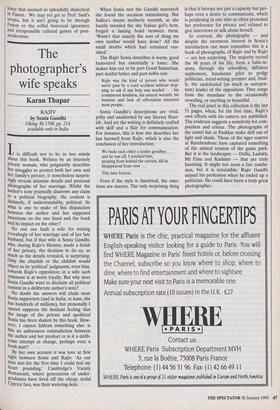The photographer's wife speaks
Karan Thapar
RAJIV by Sonia Gandhi Viking, Rs 1500, pp. 214, available only in India It is difficult not to be in two minds about this book. Written by an intensely private woman, who poignantly describes her struggles to protect both her own and her family's privacy, it nonetheless surpris- ingly reveals intimate details and personal photographs of her marriage. Whilst the author's note pointedly disavows any claim to a political biography, the content is distinctly, if understandably, political. So What is one to make of this disjunction between the author and her supposed intentions on the one hand and the book and its impact on the other?
No one can fault a wife for writing revealingly of her marriage and of her late husband, but if that wife is Sonia Gandhi, Who, during Rajiv's lifetime, made a fetish of her privacy, the decision to do so, as much as the details revealed, is surprising. Only the churlish or the childish would object to its 'political' judgments, even bias, towards Rajiv's opposition; in a wife such Comment is at worst loyalty. But why does Sonia Gandhi want to disclaim all political Content in a deliberate author's note?
No doubt the answers will elude most Sonia supporters (and in India, at least, she has hundreds of millions), but personally I cannot suppress the hesitant feeling that the image of the private and apolitical Sonia has been shaken by this book. How- ever, I cannot fathom something else: is this an unforeseen contradiction between the author and her product or is it a delib- erate attempt at change, perhaps even a fresh start?
By her own account it was love at first sight between Sonia and Rajiv: 'As our eyes met for the first time I could feel my heart pounding.' Cambridge's Varsity Restaurant, where generations of under- graduates have lived off the cheap, stolid Cypriot fare, was their watering-hole. When Sonia met the Gandhi matriarch she found the occasion intimidating. But Indira's innate motherly warmth, as she hastily mended the shy Italian girl's hem, forged a lasting bond between them. `Wasn't that exactly the sort of thing my own mother would have done? All the small doubts which had remained van- ished.'
The Rajiv Sonia describes is warm, good humoured but essentially a loner. She makes him out to be part Good Samaritan, part dutiful father and part noble son:
Rajiv was the kind of person who would never pass by a road accident without stop- ping to ask if any help was needed . . . his transparent kindness, his natural warmth, his humour and lack of affectation attracted most people.
Sonia Gandhi's descriptions are vivid, pithy and unadorned by any literary flour- ish. And yet the writing is definitely crafted with skill and a flair for communication. For instance, this is how she describes her last farewell from Rajiv, which is also the conclusion of her introduction:
We bade each other a tender goodbye ... and he was off. I watched him, peeping from behind the curtain, till he disappeared from view ...
This time forever.
Even if the style is theatrical, the emo- tions are sincere. The only surprising thing is that it betrays not just a capacity but per- haps even a desire to communicate, which is perplexing in one who so often protested her preference for privacy and refused to give interviews or talk about herself.
In contrast, the photographs — and despite the enormous interest in Sonia's introduction one must remember this is a book of photographs, of Rajiv and by Rajiv — are less surprising. The majority record the 48 years of his life, from a babe-in- arms, through shy schoolboy, diffident sophomore, handsome pilot to podgy politician, trend-setting premier and, final- ly, the undefeated (as much as unrepen- tant) leader of the opposition. They range from the mundane to the occasionally revealing, or startling or beautiful.
The real jewel in this collection is the last 51 pages, when, for the first time, Rajiv's own efforts with his camera are published. The evidence suggests a sensitivity for com- position and colour. The photographs of the camel fair at Pushkar make deft use of light and shade. Those of the tiger reserve at Ranthembore have captured something of the animal tension of the game park. But it is the landscapes — Delhi, Ladakh, Mt Etna and Kashmir — that are truly haunting. It might not seem a fair conclu- sion, but it is irresistible: Rajiv Gandhi missed his profession when he ended up a politician. He could have been a truly great photographer,










































































 Previous page
Previous page